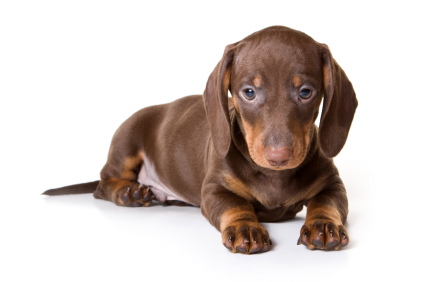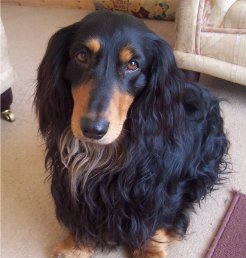
Not human bean, more than a human been!
 History
History
It is believed that the ancestors of the Dachshund existed as far back as ancient Egypt, due to artifacts found that depicted small dogs with very short legs. This German breed was developed as a badger hunter hundreds of years ago. In German, "dachs" means badger and "hund" means hound. The breed was derived from a mixture of German, French and English hounds and terriers. These dogs have many terrier traits and are excellent hunters. They have been bred to have very short legs, to help them dig as well as to help them get into the burrows where animals like badgers and rabbits reside.
The first verifiable references to the dachshund, originally named
the "Dachs Kriecher" (badger crawler) or "Dachs Krieger" (badger
warrior), came from books written in the early 1700s. Prior to that,
there exist references to "badger dogs" and "hole dogs", but these
likely refer to purposes rather than to specific breeds. The original
German dachshunds were larger than the modern full-size variety,
weighing between 30 and 40 lb. (14 to 18 kg), and originally came in
straight-legged and crook-legged varieties (the modern dachshund is
descended from the latter). Though the breed is famous for its use in
exterminating badgers and badger-baiting, dachshunds were also commonly
used for rabbit and fox hunting, for locating wounded deer, and in packs
were known to hunt game as large as wild boar and as fierce as the
wolverine.
 Dackel,
Tackel or Dachshund
Dackel,
Tackel or Dachshund

Double-dapple dachshunds are prone to eye disease and therefore are
rare. It is generally believed that the breed was introduced to the
United States between 1879 and 1885.
The flap-down ears and famous curved tail of the dachshund have
deliberately been bred into the dog. In the case of the ears, this is so
that grass seeds, dirt and other matter do not enter into the ear canal.
The curved tail is dual-purposed: to be seen more easily in long grass
and, in the case of burrowing dachshunds, to help haul the dog out if it
becomes stuck in a burrow.[citation needed] The Smooth-haired Dachshund
is a cross between the German Shorthaired Pinscher, and the Bracke. The
Long-haired Dachshund is a cross between all the small dog breeds in the
spaniel group, the German Stoberhund, and the Smooth-haired Dachshund.
The Wirehaired Dachshund is a cross between the Smooth-haired Dachshund
the Dandie Dinmont Terrier, and the German Wirehaired Pinscher.
The American Kennel Club recognizes only one breed, with six
varieties; in Britain, the Kennel Club recognizes six separate breeds.
Dachshund (Long Haired); Dachshund (Miniature Long Haired); Dachshund
(Smooth Haired); Dachshund (Miniature Smooth Haired); Dachshund (Wire
Haired); Dachshund (Miniature Wire Haired);
The standard size was developed to scent, chase, and flush badgers and other burrow-dwelling animals, while the miniature was to hunt rabbits. Due to the long, narrow build, they are sometimes referred to as a wiener dog. Not withstanding the German origin of the dachshund's name, within German-speaking countries the breed is known—both formally and informally—as the Dackel or Teckel.
The Dachshund is a breed that dates back 600 years. Historical artwork depicts small, long bodied dogs hunting badgers in Germany during the 15 th century. At this time, the dogs were used for hunting, and were prized for their hound-tracking ability, their size, and their temperament that closely matched terriers. All of these characteristics made it possible for the Dachshund to effectively track badgers and other small creatures that dwelled in holes.
